|
Ted Rosen & Scott Eckert sail W8231 from
...Killarney to Little Current and the North Channel in the Summer of 2009 |
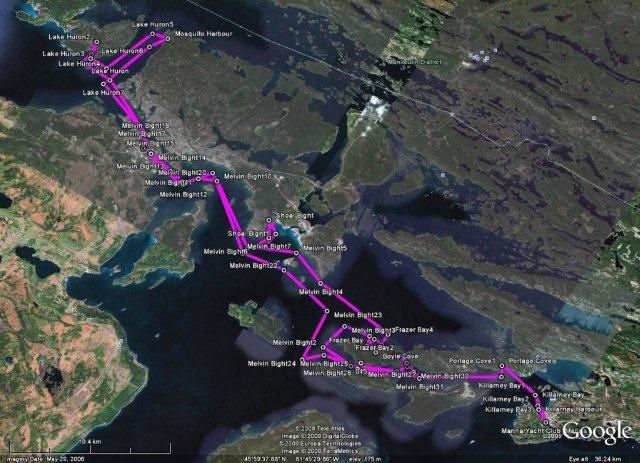 |
|
This trip started one year ago
with my introduction to Wayfarer cruising through Margaret Dye’s
book. In no time at all, I experienced two-footitis, and replaced
the CL14 which I had been sailing for 10 years in Toronto’s Outer
Harbour with W8231. The learning curve was steep, including
progressively longer solo ventures into Lake Ontario and along the
shoreline, gaining confidence in the Wayfarer's ability to handle a
wide variety of cruising and racing conditions. I also learned more
about the Wayfarer through replacing fittings and refinishing seats and
centerboard. This included an incident when a shroud bolt sheared in
modest winds requiring on the water repairs and judicious return to the
Outer Harbour Centerboard Club, from which I sail.
Through the Canadian and US Wayfarer web sites and cruise logs, plus numerous questions to Uncle Al, all of the components needed to plan and conduct my first week-long cruise were assembled. From the cruise logs, I gathered that most cruises were relatively relaxed sailing with the occasional day of exhilaration. Little did I know that the inverse would be true for our trip? During the 2009 sailing season I did a number of solo shakedown cruises, but none longer than an overnight. They provided valuable lessons in navigation, living and cooking on board, and anchoring - all relatively new to me, on the water. I did fall back on almost 40 years of mountaineering and backpacking low impact camping experience to guide many of our plans. Thanks to the many sources of information about local cruising areas, I settled on the Georgian Bay, with the intention of doing a solo cruise along the route described in the 2001 Georgian Bay cruise report. The North Channel is reputed to be a most spectacular sailing area, and a natural destination from a Toronto base. Fortunately for me, when I described my plan to my sailboat racing partner Scott, he immediately asked if I would be interested in being joined by an experienced crew, namely himself. This was a no brainer, and we agreed to finalize plans for the trip when I had returned from competing in the Ironman triathlon in Lake Placid, New York, at the end of July. I intended this cruise - especially with an excellent crew - to be a relaxing break from triathlon training. As it turned out, the week of
sailing was only possible with Scott on board, and I could not think of
a better partner to sail with. Scott has been sailing as long as
I have, and had cruised with his brother on a Wayfarer in the Yukon, as
well as being familiar with the Georgian Bay area as a youngster.
Our years of racing together allowed us to work as a team, especially
when each days conditions inevitably became challenging.
Although I had keelboat cruising experience, I had never completed more than an overnight trip in my own sailboat. Nor had I loaded a boat on a trailer, or towed it. My anchoring experience and sailing in much over 12-knot winds was limited. The trip was meant to get the process started, and expose me to all the basic cruising tasks, in hopes of many more trips in the future. My intended relaxing holiday though, morphed into a constant state of anxiety while in motion, offset by temporary states of rest when anchored and secure. 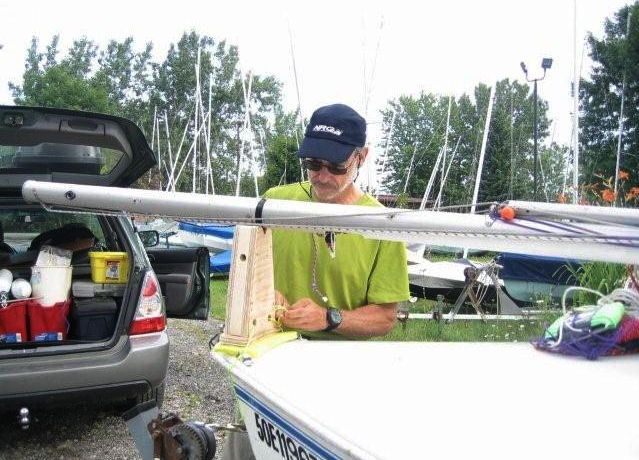 departure & mast support Our trip started on my return to Toronto, and the confirming phone call that Scott was available and ready for the planned trip. Scott was to organize the food (I later found out he had worked as a summer camp cook for geological survey teams) and I was to look after all else. We met at the OHCC to load the Wayfarer on my boat trailer, and assess any further needs. I had completely rewired the trailer earlier in the spring, yet one of the rear light lenses had been broken in storage and needed replacement, (lesson learned: in the future I would opt for a lighting board rather than conventional trailer lighting) and we decided that an additional mast support was needed at the bow. Scott being a highly skilled furniture designer and wood worker proceeded to take a few measurements and produce a custom support in no time. Thursday was spent assembling the food and all necessary cruising items with the agreement to make an early start Friday morning, in hopes of missing the August long weekend traffic. Friday,
July 31 Toronto to Killarney to Covered Portage Cove
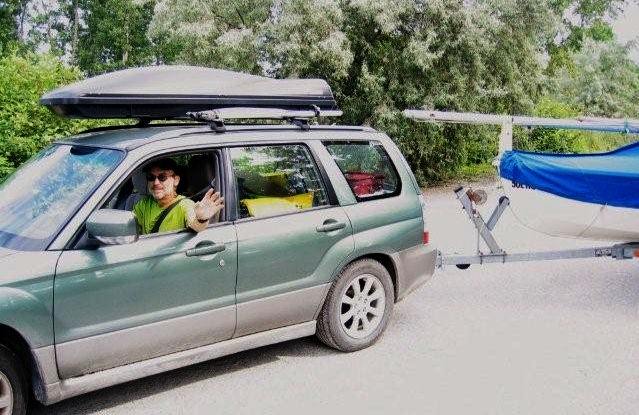 departing from the OHCC I picked Scott up at his house and we pared down the food piled on his dining room table to a reasonable quantity. It seems that Scott shopped as if he were feeding a geological survey crew. Loading the food and his personal gear in the car, we proceeded to the Outer Harbour Centreboard Club to pick up the Wayfarer on the trailer and head north. My first trailer experience was in now to be in Toronto long weekend commuter highway traffic. I needed to remind myself constantly that I was towing something bigger than my car. My anxiety was unnecessary, and all went smoothly. After about 30 minutes we pulled into a service area to check the tires and confirm bearings were not hot, as well as pick up some coffee. The next five hours of driving went quickly as Scott told story after story of his past adventures. 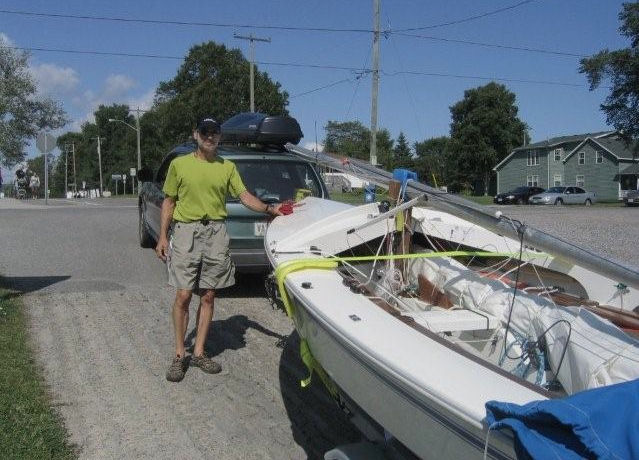 launching in Killarney We arrived in Killarney before
5pm. As reported in other cruise logs, the main street ends at a boat
ramp. (The adjacent fish shop charges $7.50 each for put-in and
take-out.) Parking for vehicle and trailer are conveniently
located behind the church about one block away, with a daily “donation”
of $5. By Toronto standards we were ahead of the game. The
weather was clear, so we loaded the Wayfarer, stored the vehicle and
cast off. Although the wind was not strong, it was on our nose
for the length of Killarney channel, and we were continuously tacking
as we made our way out to Killarney Bay, to the amusement of local
residents lounging on shore. I had both paper charts and a
GPS. The rapid departure did not give me the opportunity to plan
a route, but fortunately we identified an anchorage which turned out to
be Covered Portage Cove, a very popular spot for the night. Due
to our shallow draft, we were able to access a quieter portion of the
bay, to allow both good anchorage as well as access to shore as needed.
The anchors set well in the mud and weed bottom. Generally the two
anchors I carried, a 5-lb Bruce, and a larger guardian anchor
complemented each other and held well. I am constantly amazed how
the Wayfarer swings at anchor, which is quite unsettling without the
boom tent, but virtually unnoticeable with the tent up and the view of
surroundings blocked.
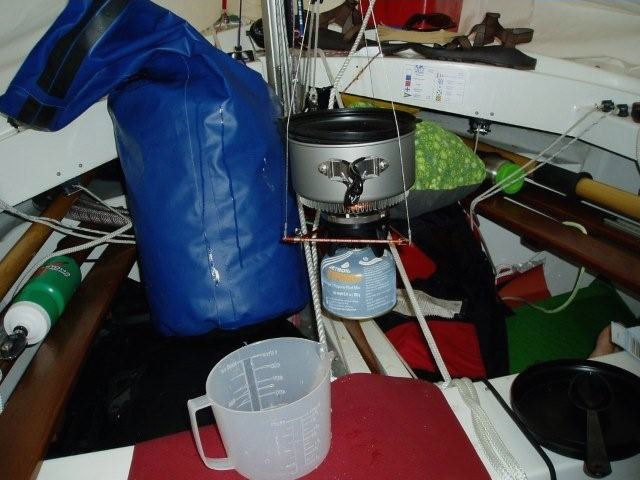 cooking set-up 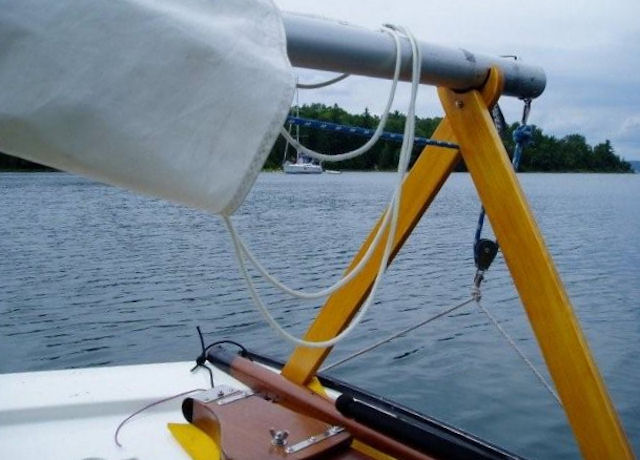 boom crutch 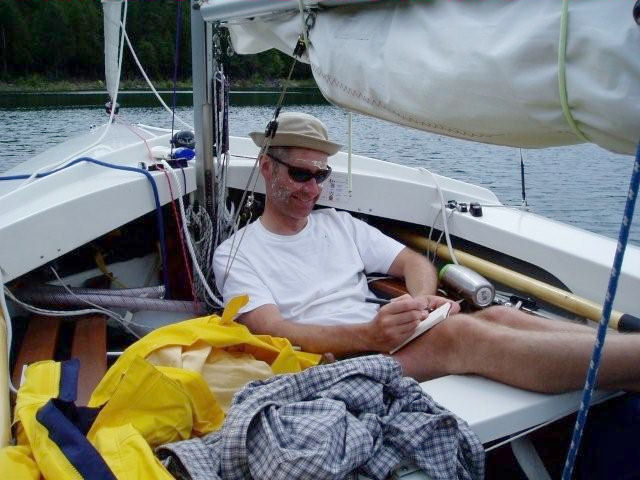 Scott relaxing on board I had researched and practiced
cooking on the Wayfarer, and had purchased a Jetboil camping
stove. It had the advantage of being very efficient due to a heat
exchanger system on the pot, use of a gas cylinder avoiding liquid fuel
spills, and had and add-on suspension system, allowing the entire
cooking system to be suspended from the boom. This was an
inverted gimballed arrangement which worked perfectly, adjusting to any
motion of the Wayfarer with no hazard of hot pots or lit stove falling
over. With dinner complete, we set the Wayfarer up for sleeping with
Thermarest pads, sleeping bags and enclosed the Wayfarer with a boom
tent obtained from Hans Gottschling. Scott was later to say that
it was amazing that the boom tent was both easy to set up and worked so
well. Sleeping in the confined quarters was a learning
experience. Scott initially tried sleeping with his head forward, ala
Frank Dye, but that lasted only one night. It took a few days of
experimentation to determine the ergonomics of comfortable sleep.
August
1. Covered Portage Cove to Frazer Bay
We got a late start, following
breakfast and a visit to shore. Sailing west through the
Lansdowne Channel, we were continuously tacking into the increasingly
stronger winds. As we rounded Badgeley Point, Frazer Bay was filled
with whitecaps and waves. The 15-knot and higher wind forecast
was to plague us for the next week. It seems that this year has
had much higher winds than was typical. The conditions were
certainly more than our comfort level allowed, and we had previously
agreed that as a first venture into multi-day cruising, we would sail
conservatively. We rounded the point and tucked into the first
inlet to assess our next steps. A careful look at the chart
showed a better protected Boyle Cove further east, and we proceeded to
this location to anchor for the day. The afternoon was spent
swimming, eating lunch, and taking it easy. Swimming from the boat gave
the opportunity to practice using the main sheet as a foot loop to get
back in the Wayfarer, should that ever be needed in a man overboard
circumstance. It rained later in the afternoon and more heavily
during the night. The boom tent worked well. Through the entire
cruise, very little water entered the Wayfarer, all of which found its
way to the bailer scuppers, and could easily be sponged out.
August
2 Frazer Bay to Stoney Point
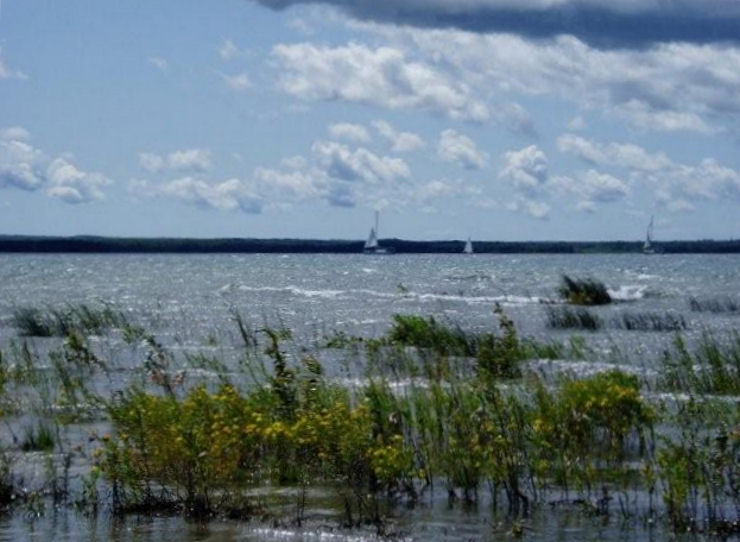 View from Stoney Point We were up at 6am, as we found
was both natural and needed due to the daily wind patterns. The
forecast was for 20-kt winds gusting to 40kts from the west, so we
needed to sail early to limit our exposure to the higher wind and seas.
Under the forecast conditions, we may have been wiser to sail north or
south, rather than into the wind. Our objective was Little Current. The
mailsail was reefed by 10:30 am, and once again we sought refuge in a
bay protected by Stoney Point identified on the chart as Shoal
Bight. Once again we found a soft bottom for anchoring, and in
addition tied the stern to shore for ease of access. Following
lunch we hiked across Stoney Point to the North Channel, allowing us to
confirm that the sailing conditions were well beyond our comfort level.
Keelboats were motoring into the wind. Scott pointed out poison
ivy on our walk, and whether it was here or from another anchorage, I
developed a mild case of this affliction. Caution is advised.
Each day’s high winds diminished to calm at nights, and at various
times mosquitoes became an annoyance. In anticipation of this, I
had brought a mountaineering bivy sack, which although confining kept
the bugs out. There must be a better solution using mosquito
netting, but I have not found it yet.
August
3 Stoney Point to Rouse Island
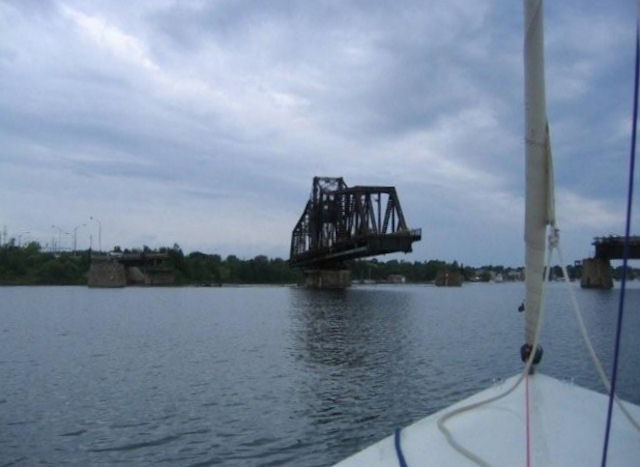 Little Current bridge Red sun in the morning.
Hmmm. We dressed for the worst. We intended to be at the Little
Current Bridge crossing this day, somewhat later than the original
schedule. Foregoing breakfast (and to Scott’s dismay, coffee) we
were sailing before 7 am. Once again the winds started to
increase with some rain, but as we approached the bay near Strawberry
Island, the winds became shifty and variable. At times I
felt I was heading away from our destination, and we clearly were not
going to meet the 9 am bridge opening, despite a valiant rowing effort
on Scott’s part with the oars. We chose to anchor near the bridge
to wait for the 10 am opening, rather than wear ourselves out
manoeuvring around the wind shifts and other boats queuing up. As the
appointed hour approached, we retrieved the anchor and reached back and
forth near the channel marker, waiting for signs of the bridge
moving. In retrospect it was much like the start of a race, and
that is something that Scott and I were comfortable with. Most
race starts are not constrained by bridge abutments, larger boats
motoring across the line, and the prospect of a massive bridge crushing
your mast. Once through the gauntlet, we tied up at the public
dock while Scott took the opportunity to phone home and pick up coffee
and breakfast. It was a cool, cloudy day, threatening rain, yet
we had achieved our objective of passing the Little Current Bridge, and
felt very good about that. The facilities at Little Current had
been vastly improved since 2001. Finger docks were filled with a
large variety of sailing and motor yachts and clean washroom facilities
are available. Our 16-foot dinghy felt particularly small in this
company. There is no charge for day use, but overnight charges
were near $2 per foot. I thought about the 40’ Hunter adjacent to me
paying $80 per night, and remembered why I was sailing a Wayfarer.
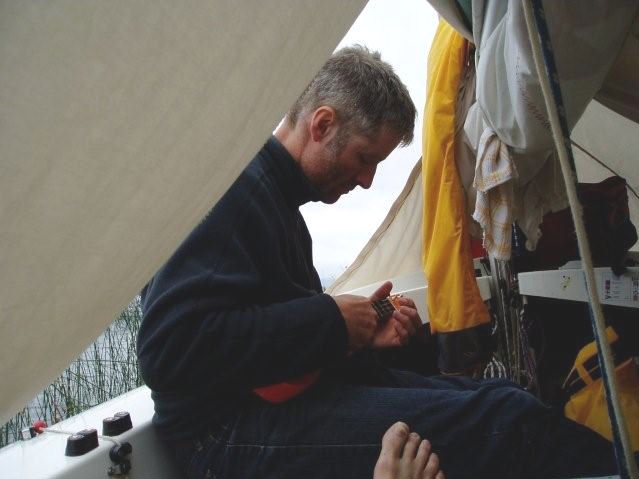 Scott playing Emergency Ukelele 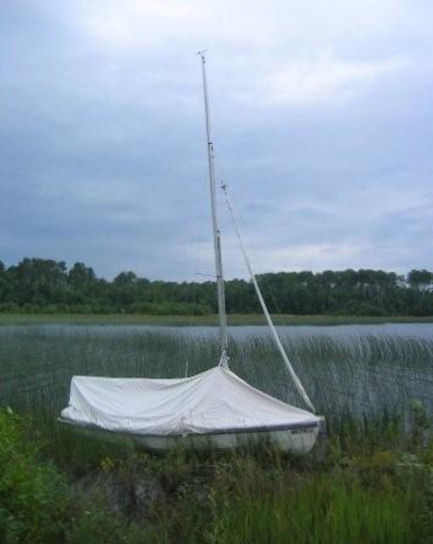 Rouse Island anchorage With breakfast and phone calls
complete, it was still early in the day, so we cast off with the
intention of sailing as far west as conditions would allow. As we
passed the Waubuno Channel the winds and waves were piping up again,
and with reefed mainsail, we entered the anchorage between East and
West Rouse Island. We were now being blown to the northern end of
the bay, at great speed. In an attempt to stabilize our situation, we
dropped anchor, but the anchor dragged, and we found ourselves stopped
by reeds at the shallow North end with no harm done. Thankfully,
the bay was not filled with shallow rocks. Out came the oars and
we fought our way to the west side of the bay, where more protection
was available, tying onto shore. Once again our sailing day was
shortened by wind and waves. Lunch was followed by a short walk,
dinner and a quiet evening. Scott brought out his emergency ukulele. This was a
bright orange colour ukulele intended for those quiet times when
Scott’s urge to create music could not be restrained.
The dinner/tent set-up ritual
had now become quite efficient, almost effortless. As it became
dark, the strong winds of the day abated, and we were faced with ...
mosquitoes. After an hour, the annoying insects became too much
and we pulled back the tent to row further out into the now calm
bay. It did not really help reduce the mosquito density, but we
anchored and pretended to sleep. Through the night there was a
thunder storm, and I reflected on the discussion
about lightning in the Wayfarer Institute of Technology web
site. Counting the number of seconds between lightning flash and
thunder, indicated that the storm was sufficiently far away as to not
be an immediate concern. Scott was not so convinced.
Near 5 am, the wind did pick
up, and it appears that it clocked 360°, allowing the anchor rope
to wrap around the rode and dislodge the anchor. Scott said he
could see the panorama of our bay through the screened stern boom tent
window just prior to our being blown into the reeds once again.
So much for a good night’s sleep, and confidence-building
anchorages. We rowed back to our “dock” and accepted that the day
would soon begin.
August
4 Rouse Island to Mosquito Harbour
Throughout the cruise, we could
easily receive marine weather broadcasts on the handheld marine
transceiver I had brought. At one point I had explained to Scott
the various protocols for transmitting, should we need to. We had heard
reports of a keelboat Mayday call. The forecast for the day was
20-25 kt winds and 1-2 meter waves. We no longer felt we could
progress westward, and resigned ourselves to an idle day, when one of
the keelboat sailors also anchored in the bay rowed his inflatable
tender over to chat. He suggested Mosquito Harbour at the north
end of the Waubuno Channel was a more pleasant location. Within
20 minutes we were sailing for this anchorage, through increasing wind,
but at least we were moving. The bay was west facing and we were
blown into it but found a more protected niche on the north
shore. The holding was good for our anchor although large
submerged logs had the potential for fouling the anchor, and we spent
some time setting the anchors to allow easy retrieval. By the
time we had tied off the stern, whitecaps and waves were invading our
bay, but we were reasonably protected. Another short day, with
swimming and some short hikes on the trail and dirt roads which
appeared as if a developer had ambitions for the adjacent land.
Walking to the exposed open water north of Northwest Point confirmed
our decision to stay put: high winds and whitecaps filled the
view. We were joined by two larger motor launches, which with all
their power and manoeuvrability chose to anchor for the night.
Towards the end of a quiet afternoon the owner of one of the boats
rowed his inflatable over to us to chat. Asking whether we were
daysailing and in need of accommodation for the night, we assured him
that we were all set for the evening. He referred to sailboats as
“stick boats” and we understood that to mean that many of the keelboats
spend the greater part of their time motoring in the North Channel.
Having no motor, we sailed, rowed or anchored. We did appreciate
his concern for our well being. Oddly, we were not bothered by
mosquitoes in Mosquito Harbour, and the incoming high pressure system
brought cool dry weather, allowing one of the most restful nights of
the cruise.
August
5 Mosquito Harbour to Covered Portage Cove
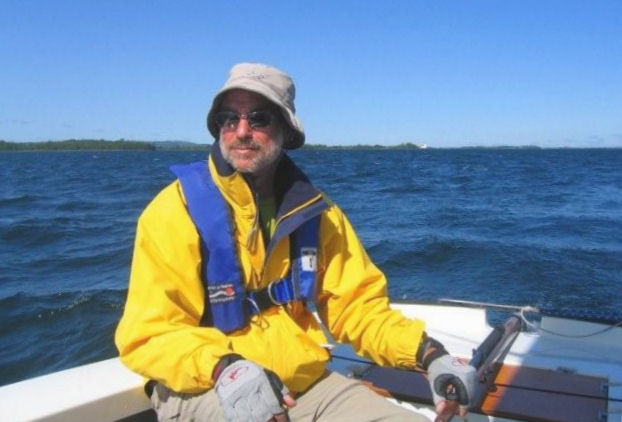 return from Little Current - Ted at helm We had passed our cruise
midpoint and it was time to start working our way back to
Killarney. With strong winds again forecast for the day, we were
up at 6 am and sailing 30 minutes later. Waubuno Channel was
manageable, but rejoining the main bay raised the question, “Is it time
to reef?” I had learned that if you ask the question, it is likely
already too late, and Scott at this point had developed good skill at
reefing the main. We had roller furling on the jib, but reducing
the headsail did not work well. Now with the wind astern, I aimed
to maintain a broad reach to reduce accidental gybe potential, and we
sailed at 5-6 kt boat speed back to Little Current. The unexpected
appearance of a huge cruise ship bound for Little Current further added
to the increasing challenge of sailing. Fortunately they were
clear ahead by the time we were in the narrower channel. Rounding up to
the finger docks had its moments, but a second try, aided by a few
helpful sailors on the dock, allowed us to tie off while waiting for
the next bridge opening. Scott was off once again for phone
calls, coffee and breakfast. The current in this channel
apparently changes both speed and direction, and on this day it seemed
rather strong flowing in an easterly direction, pushing us towards the
bridge. Unsure of how long we would need to travel the distance
from the dock to the bridge, we cast off 15 minutes before the hour,
resulting in about 20 minutes of tacking back and forth in the channel
and attempting to avoid the other boats queuing up for the
morning. The wind required an angular approach to the bridge, and
once again our many race starts allowed us to cross the line without
being called over early, or being crushed by either a larger boat or
swinging bridge. Fortunately there was no general recall.
Typically, we would plan to
take each section of the day separately, evaluating the safety of
continuing and constantly on watch for protected shelter. The
west wind was likely as strong as we had experienced in previous days,
but now we were sailing on a broad reach. The apparent wind was much
less, and we were no longer pounding into large swells. In fact
we were riding the swells, at upwards of 6 knots, and at times
surfing. We seemed to be sailing at least as fast as the larger
boats surrounding us. I marvelled at the stability of the Wayfarer in
all of the rough conditions we had experienced and it gave great
confidence to be out in the larger open water. We had now been
sailing continuously for 6 days – more continuous sailing than I had
ever previously done. We were moving at great speed, and rather
than risk a change in weather by stopping for lunch, we headed back to
Badgeley Point. What had taken us 2 days to sail was now
completed in 2 hours. We considered the alternative route south of
Badgeley Island, but once again winds and wave had become intimidating
by noon, and we opted for the more protected Lansdowne Channel. Rather
than immediately returning to Covered Portage Cove, we poked our nose
into a number of smaller bays along the way. The fluky winds, and
rock-studded bay thwarted our efforts to anchor resulting in our
re-entry to the Lansdowne channel under jib alone. This was
relatively new to me, and the jib pulled us along at 5 knots, with no
concern for accidental gybes. All seemed good, until we found
ourselves approaching Covered Portage Cove with the need to sail
upwind. A previous experience in these winds suggested that the
jib would not get us where we needed to go. We attempted rowing, but
the wind was too strong. We unfurled the jib and sailed into open water
to raise the main. Without the ability to sit head to wind,
raising the main, even as reefed, failed and the bolt rope escaped from
the mast track, followed by the halyard swage jamming in the mast
sheave. So much for a relaxing sail.
This was one of our longest
days on the water and we later decided that our conservative earlier
days were a good choice. In spite of the confusion, it was a
credit to our sailing relationship that we could assess what needed to
be done next, talk it out, and solve the problem. We found a
quiet recess in the cove to bring the Wayfarer to shore, secure it, and
lower the mast while on the water, to allow access to the mast head.
Our little drama was somewhat comically conducted adjacent to a couple
of huge cruisers, complete with multiple generations of grandchildren
through grandparents, all obliviously acting as if they were on
holiday. With the mast lowered, I worked my way over the slippery
rocks to the mast end, now some distance from the stern and with a lot
of manipulation the swage was freed, and the halyard returned to its
proper position. Gaining experience raising and lowering a mast
on the water is useful, but not recommended for a multi-day
cruise. Needless to say, the forestay cotter pin ring liberated
itself, and fortunately I had multiple bits and pieces in a repair box
to allow replacement. Carrying a leatherman tool was really
useful. With the mast up again, raising the main allowed beating into
the bay to our quiet cove with only a bit of pinching to avoid the
exposed rocks and anchored boats. A big sigh of relief was given
once the anchors were set and holding. It was time to get out the
“emergency ukulele” and offer thanks to the sea cruising gods for
another safe anchorage. (Sea gods appear to like bluegrass music)
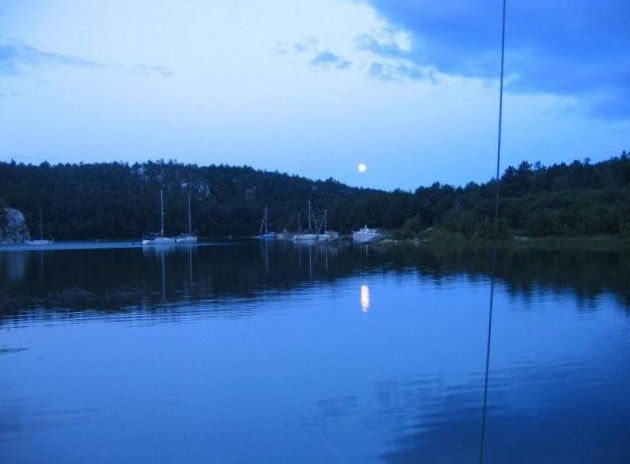 Covered Portage moon Our cruise was close to
complete. From Covered Portage Cove it was even possible to
access the cell phone network and send text messages home to say all
was well, and we would be returning Thursday evening.
August
6 Covered Portage Cove to Killarney and Toronto
We awoke at 6 am on the final
morning, and were sailing shortly afterwards, navigating around Sheep
Island to the relatively obscure channel inlet to Killarney. I
had relied extensively on a GPS with marine charting for our
navigation, backed up by paper charts. Throughout the cruise I
found it quite challenging to both focus on the helming and sail
management, and know where on the paper chart we were. The GPS
solved this admirably, and served as a constant reminder that should
the GPS fail, a high level of chart reading skills would be needed.
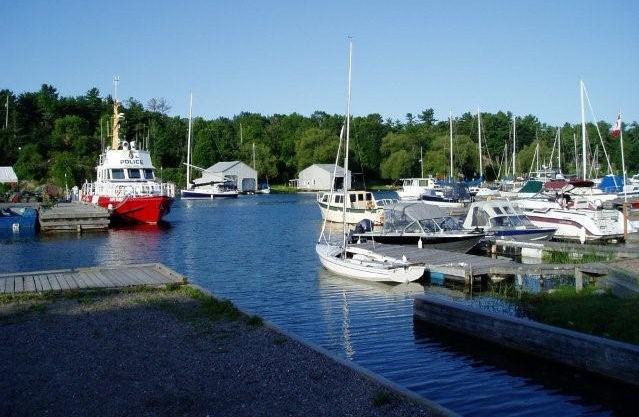 return to Killarney Harbour 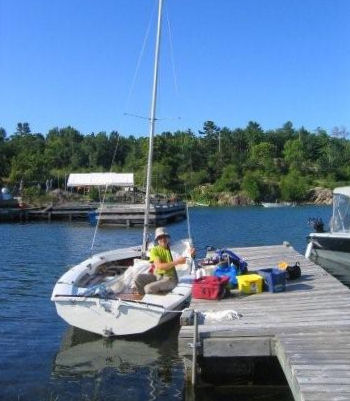 unpacking and preparing to haul out Our last morning was the most
relaxing sailing of the week, with relatively light winds. We were back
to reaching up Killarney channel and a quick rounding up to miss
the coast guard rescue vessel filling the bay at the boat ramp got us
to the unloading dock unscathed. Our first priority was to have a real
breakfast, and coffee, followed by retrieving the car and trailer and
packing for the drive home.
We were really pleased to have
successfully completed our planned cruise, adapting to the strong wind
and wave conditions in a safe manner, in a boat which was smaller than
any we had seen in the week.
Although a week of relaxing sailing full days was not realized, our first “real” cruising experience exposed us to a wide variety of sailing and challenged our ability to sail safely in conditions approaching the limits of our comfort level. Spending a continuous week sailing gave rise to thoughts of how our future cruises might be different. Sailing in this area requires constant vigilance regarding water depth and submerged rocks. We encountered the occasional unexpected shallows, frequently hidden by rough water. During the week, we had decided to leave the rear seats in place, although many cruisers choose to remove them. I found the sailing more comfortable with this seating arrangement, and the storage capacity of the Wayfarer did not cause crowding. We were curious whether any modifications had been considered for reducing the mainsail height, and raising the goose neck, giving more headroom and visibility when sailing upwind especially in higher wind conditions. Scott used a conventional racing life jacket, but I found the inflating life vest quite comfortable. The rings on the vest, intended for a safety line when solo sailing, served well to secure the wrist loop of the handheld GPS, which then could be tucked in my jacket pocket until needed. The GPS was then readily available for quick checks, but not otherwise in the way. The last item regarding boat set-up was another reminder of the importance of checking equipment. At the end of the cruise, I lightly tugged on the forward hiking strap and the securing line broke due to abrasion during the trip. This could have been quite disastrous on the number of occasions when Scott hiked out during a gust. Keeping an eye on such fittings and fixtures at the end of each day is a worthwhile task. As a novice cruiser and
Wayfarer owner, I also learned that a sailboat takes a beating during
road travel and a week of cruising. Awareness of the potential of
damage is an important component of damage control, and inevitably
post-cruise cleanup and (minor) repair are needed. The hull did
receive a minor coating of road asphalt from highway maintenance
patches, and I would explore purchase of an undercover for future
trailering. The positive side of this was that the day following
our return, I turned the Wayfarer on its side, and swabbed the hull
with solvent, cleaning debris, inspecting and patching minor damage and
loose keel band screws. Minor touch-up of wooden seats,
centerboard and rudder were also needed, preparing for the remainder of
the sailing season.
This cruise would not have been as successful without the information gained from the Wayfarer cruise logs, helpful suggestions from Uncle Al and his many worldwide Wayfarer contacts, and Scott’s participation. Thanks to all. Ted Rosen W8231 |